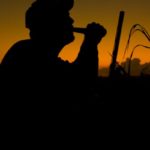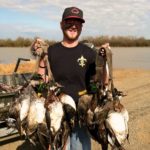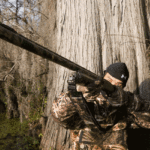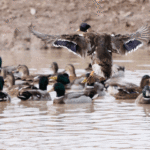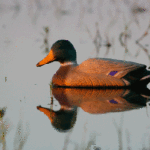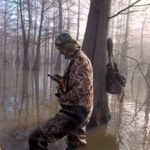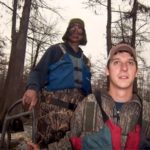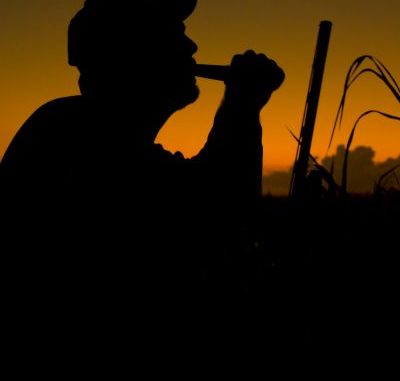
These hunters have learned that you can sit in stationary blinds and hope ducks come to you — or you can move around and find out where the birds really want to be.
I always wondered while fishing during the winter if all those ducks I kept jumping in the river lakes just off the Ouachita River between Monroe and West Monroe would eventually return to that same spot.
I imagined myself sneaking in there in my white-and-red metal-flake bass boat clad in camouflage netting to see if I could pop off a couple shots on those returning ducks.
Little did I know it at the time, but that’s exactly how some people hunt the Ouachita River and its tributaries. Simply put, they ride around until they jump some ducks, and then they return the next morning.
“If the ducks want to be there, then that’s where I want to be,” said avid duck hunter Chance Havard from Simsboro. “And the waters up and down the Ouachita River — even some of the surrounding lakes — my buddies and I hunt all of them.
“We just jump around to wherever the ducks are.”
Havard started jumping duck holes about three or four years ago with two of his buddies, Jason Floyd and Robert Redding. And if last year was any indicator — the trio killed approximately 450 ducks — they aren’t going to slow down any time soon.
Although they do a lot of jumping around all of Ouachita Parish, Havard used D’Arbonne Refuge between Lake D’Arbonne in Farmerville and the Ouachita River in Monroe as an example of just how good this jump-around hunting can be.
“The refuge doesn’t get a lot of hunting pressure, but it can get a little crazy in there because there are so many ways to get in and hunt,” Havard said. “People wade in off the roads, some paddle in with pirogues and there are some people that come in by boat from Joe Bob’s landing.”
So Havard recalled a few times when he entered the refuge in his mud boat only to have folks suddenly show up behind him unannounced because they walked in from the road.
“I hunt from my boat and put in at the Bean Field,” Havard went on, “and we started getting a little more pressure up there last year. A lot more people started coming in, where before there might have been three trucks.
“I guess people are now finding out about it.”
Pressure notwithstanding, Havard said killing ducks at D’Arbonne Refuge and other nearby places like the Upper Ouachita Refuge and out on the Ouachita River itself is all about the weather and water level.
If the river is high, there’s a lot of water to go around. In fact, Havard killed ducks a couple years ago launching at the top of the hill at the Bean Field landing and running through cypress tree tops to get to his spot.
“Then we had to put 30 feet of decoy string on the decoys, and I hid my boat in the tops of some cypress trees,” Havard said. “But I would much rather be in shallow water where I can park my boat in some brush, and get out and wade to a cypress tree.”
If you think Havard would rather be in shallow water to ensure he’s hunting a spot where ducks are feeding, he doesn’t even think feed is the main attraction at D’Arbonne Refuge. Rather, he thinks the expanse of water is more of a resting spot in a heavily used flight path.
“We’ve killed them with the water up, and I know they weren’t eating anything,” Havard explained. “There might be some duck weed down around Boggy (a popular backwater off D’Arbonne Bayou), and there are some oaks up on the north end that ducks will feed under when they flood. But, for the most part, the refuge is just a big stopping spot.”
As for the weather, D’Arbonne Refuge offers two distinctly different kinds of hunting that gives Havard the opportunity to have a good hunt no matter what’s going on in the sky.
One is timber hunting, and the other is open water.
During a sunny day in the timber, Havard looks for holes in the trees, but he claims that not just any old hole will do. He looks for one that is in the path that ducks have shown a propensity of flying and sets up there.
“If you could draw an imaginary line across any of the refuges or wildlife management areas up here, there is one where the ducks consistently fly back and forth,” Havard explained. “Set up in a hole under that line, and when the ducks come over, they look down for a second, and then they’re just right in your face.”
On cloudy days, Havard sets up in the wide-open spots where he can see ducks for a long way off. This allows him to work the birds better, as he can read their body language from a distance rather than having them on him in a split second like in the timber.
Since he hunts out of a Pro-Drive boat, he always tries to find something to hide his boat in so it looks natural because ducks are quick to flare off of a boat with a pop-up blind out in the bald open.
“I try to just find some high brush where I almost have to shoot through bushes,” Havard said. “And making your boat look as natural as possible is key. I try to get all my camo the same as where I’m hunting.
“On my pop-up blind, I’ve got a lot of moss that blends in with the gray colors of the cypress trees.”
While Havard’s plan for hunting D’Arbonne Refuge sounds like it is as easy as riding around and finding where the ducks want to be and setting up appropriately based on the condition of the sky, it’s not as simple as it sounds.
Especially considering that the refuge has several areas that are closed to hunting.
“You can’t just pull up and hunt anywhere,” Havard said. “There are a bunch of no-hunting zones that you’ve got to be aware of. And it takes a lot of time out there to figure out where the ducks want to be each year.
“Our honey holes from last season may not be worth a crap this year.”
The solution to this problem is to burn a lot of gas riding around and looking. In fact, if Havard finds himself on a slow hunt when he’s not killing any ducks, he’ll pack up and ride around until he jumps some.
“Where you jump them is where they’re going to come back to,” Havard said. “A lot of times, I’ll mark that spot and set up there the next morning. We kill a lot of ducks that way.”
The best times to hunt the two major refuges along the Ouachita River and the nearby wildlife management areas are days after a cold front when new ducks arrive. They are easy to spot because flight ducks tend to run bigger than local ducks, and their feet are a bright orange in contrast to the gold feet of resident ducks.
“Those new ducks are easier to fool,” Havard said. “It can get tough when you’re trying to kill ducks that have been here because they are a lot smarter about where folks have been shooting at them.”
And hunting during the week is an absolute bonus, as you will have the place to yourself more often than not.
However, don’t let the fact that you can’t get off work discourage you from hunting: All those ducks Havard and his buddies killed last year? Except for some time at Thanksgiving and Christmas, they mainly hunted the weekends.
They limited out on 13 trips to public water throughout Ouachita Parish and killed close to 450 ducks. Their best day was when 30 to 40 green heads at a time fell on them the morning after a strong cold front.
If you gave up on duck hunting in the last few years because it became harder to find a place to hunt, head to Ouachita Parish this year to sample some of Louisiana’s best public-land duck hunting.
Just don’t settle on any one place because if you’re looking to kill ducks rather than just sight see, it pays to jump around.
